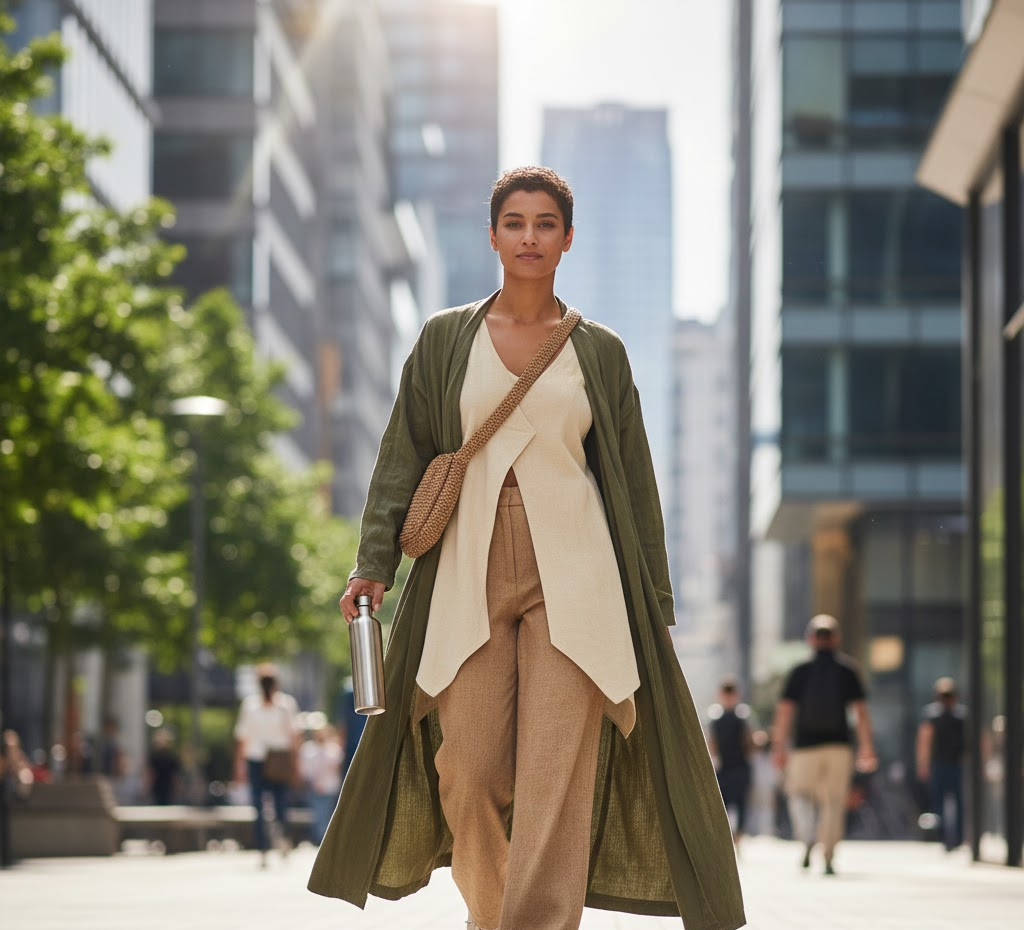If fashion could speak, 2025 would be the year it whispers one message louder than trends, seasons, or luxury labels “Wear better, not more.” As consumers rethink their wardrobes, Sustainable Fashion has moved from a niche experiment to a full global shift. What started as a quiet conversation about ethical clothing now sits at the center of the industry’s transformation, backed by innovation, transparency, and conscious consumer choices.
Sustainable Fashion is no longer a buzzword; it’s a 2025 lifestyle movement reshaping what we buy, how we shop, and why our choices matter.
Table of contents
- The Turning Point: Why 2025 Became Fashion’s Wake-Up Year
- From Runways to Reality: How Sustainable Fashion Became Mainstream
- The Rise of Smart Eco-Materials That Are Changing Fashion Forever
- The Psychology Behind the Shift: Why Consumers Choose Sustainable Fashion
- The New Mood of 2025: Slow Living, Slow Dressing
- Beyond the Closet: The Global Impact of Choosing Sustainable Fashion
- The Real Innovation: When Technology Meets Sustainable Fashion
- The “Meaning Over Material” Styling Trend Taking Over 2025
- How to Build a Sustainable Wardrobe Without Starting Over
- Why Sustainable Fashion Will Dominate the Next Decade
The Turning Point: Why 2025 Became Fashion’s Wake-Up Year
2025 marked a powerful shift in global consumer behavior. According to the Global Fashion Sustainability Report 2025, over 68% of shoppers now prefer eco-friendly clothing, a jump from just 43% in 2021. This shift didn’t happen randomly it was fueled by three major forces:
- Increasing awareness of textile waste, which reached 100 million tons in 2024.
- Government-driven environmental regulations that pressured brands to adopt greener practices.
- The rise of Gen Z and Gen Alpha shoppers, who actively demand ethical production and transparency.
Moreover, AI-driven supply chain tools now allow brands to track emissions, reduce waste, and forecast demand more accurately bringing Sustainable Fashion into a smarter, data-supported age.
From Runways to Reality: How Sustainable Fashion Became Mainstream
A decade ago, eco-friendly clothing was minimalistic, neutral-toned, and limited. But in 2025, Sustainable Fashion is bold, expressive, and widely accessible. High-end designers and fast-fashion companies alike now integrate sustainable materials into their main collections, not just “eco capsules.”
Even more impressively, circular design is becoming the norm. Brands now design products that can be repaired, recycled, or upcycled with ease.
Some notable 2025 landmark changes include:
- 89 major brands signed the Circular Fashion Commitment 2025.
- 60% of global luxury houses use recycled fibers in at least one signature collection.
- Global resale platforms saw a 45% increase in sales.
Sustainable Fashion isn’t another temporary trend it’s the new standard.
The Rise of Smart Eco-Materials That Are Changing Fashion Forever
The materials behind Sustainable Fashion have evolved dramatically. Today, the most innovative fabrics not only reduce harm but also improve performance, comfort, and longevity.
Here are the game-changers of 2025:
1. Lab-Grown Leather Alternatives
Mycelium leather, cactus leather, and pineapple leather saw a 200% production increase, proving that luxury doesn’t need animal cruelty.
2. Recycled Synthetics with Lower Carbon Footprint
Brands now recycle fishing nets, plastic bottles, and industrial waste into high-quality fibers, cutting carbon emissions by nearly 70%.
3. Regenerative Cotton
Unlike organic cotton, regenerative cotton improves soil health and biodiversity. By 2025, 12% of global cotton production adopted regenerative practices.
4. Plant-Based Dyes
With chemical dyes polluting nearly 20% of global water sources, the shift toward tea, turmeric, algae, and beet dyes has become a breakthrough.
These innovations prove that Sustainable Fashion is not just ethical it’s smarter and more technologically advanced than ever.
The Psychology Behind the Shift: Why Consumers Choose Sustainable Fashion
Interestingly, the rise of Sustainable Fashion in 2025 is not only about environmental concerns it’s also about identity, values, and emotional connection.
According to research from Fashion Futures 2025:
- 72% of shoppers feel “proud and responsible” when choosing sustainable pieces.
- Minimalist and conscious wardrobes reduce decision fatigue by 40%.
- Wearers associate sustainable clothing with higher perceived quality and longevity.
The modern shopper understands one powerful truth: Fashion that lasts feels better than fashion that trends.
The New Mood of 2025: Slow Living, Slow Dressing
Sustainable Fashion fits perfectly into the global slow-living movement. As people slow down their lifestyles focusing on wellness, mindful consumption, and intentional choices—their wardrobes naturally reflect it.
Key slow-fashion habits shaping 2025
- Buying fewer, higher-quality pieces
- Choosing timeless over trend-driven styles
- Repairing and re-wearing garments
- Renting outfits for events
- Supporting small, ethical designers
Instead of 30-item hauls, the 2025 shopper invests in curated wardrobes that feel personal, authentic, and meaningful.

Beyond the Closet: The Global Impact of Choosing Sustainable Fashion
Every sustainable garment you choose creates measurable benefits. Here’s what one eco-friendly piece can do:
- Save up to 2,000+ liters of water
- Reduce carbon emissions by up to 70%
- Cut textile waste that would take 200+ years to decompose
- Lower chemical pollution linked to chronic health issues
- Support fair wages for garment workers
In 2025, Sustainable Fashion has transitioned into a human movement—not just an environmental one.
The Real Innovation: When Technology Meets Sustainable Fashion
Sustainable Fashion in 2025 is tech-driven, future-focused, and digitally enhanced.
Here’s what’s shaping the next generation of fashion:
AI Supply Chain Tracking
Brands use AI to track water usage, energy consumption, and waste in real time.
3D Printing for Zero-Waste Design
Designers can now create garments with no fabric scraps, reducing waste dramatically.
Virtual Try-Ons
AR try-on tools cut the return rate by 22%, reducing carbon emissions from shipping.
Digital Clothing
Gen Z consumers now buy digital outfits for socials and metaverse platforms, reducing physical waste.
Fashion has never been this futuristic or this conscious.
The “Meaning Over Material” Styling Trend Taking Over 2025
One of the most exciting style shifts of 2025 is the rise of “Meaning-Based Styling.”
Consumers no longer ask:
“What’s trending?”
They ask:
“What does this piece represent?”
This shift gives Sustainable Fashion a bold new identity, inspiring styling choices centered on:
- Colors inspired by nature
- Neutral and earthy palettes
- Organic textures
- Multifunctional silhouettes
- Fabric-with-purpose outfits
Fashion becomes emotional, spiritual, and expressive not disposable.
How to Build a Sustainable Wardrobe Without Starting Over
Many people think Sustainable Fashion requires replacing their entire wardrobe.
It doesn’t.
Here’s the 2025-approved approach:
- Wear what you already own. The most sustainable item is the one in your closet.
- Thrift strategically. Look for timeless silhouettes, not impulse trends.
- Choose modular pieces. Items that pair well with everything reduce waste.
- Invest in quality staples. Fewer but better pieces build a stronger wardrobe.
- Repair, don’t discard. Mending extends clothing life by years.
- Support transparent brands. Choose companies that share production details openly.
Small changes create big impact.
Why Sustainable Fashion Will Dominate the Next Decade
Industry analysts predict Sustainable Fashion will grow into a $400 billion global market by 2030.
So what’s driving the unstoppable momentum?
- Growing climate concerns
- Widespread demand for ethical practices
- Government restrictions on fast-fashion waste
- Increase in resale, rental, and circular brands
- AI-driven transparency and accountability
When sustainability meets style, convenience, and innovation, the future of fashion becomes undeniable.
Final Thoughts
Sustainable Fashion is not a trend. It’s the new blueprint for how the world dresses.
In 2025, fashion lovers aren’t just choosing garments they’re choosing values, responsibility, and long-term impact. The future of style is conscious, innovative, ethical, and deeply human.
When you choose Sustainable Fashion, you’re not just wearing clothes.
You’re wearing change.


